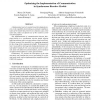121
click to vote
RTAS
2008
IEEE
15 years 7 months ago
2008
IEEE
Instruction scratchpads have been previously suggested as a way to reduce the worst case execution time (WCET) of hard real-time programs without introducing the analysis issues p...
118
Voted
RTAS
2008
IEEE
15 years 7 months ago
2008
IEEE
A hybrid scheduling algorithm is proposed, which integrates features of the Fixed Priority (FP) and Earliest Deadline First (EDF) scheduling policies. It is shown that this hybrid...
115
click to vote
RTAS
2008
IEEE
15 years 7 months ago
2008
IEEE
A fundamental asset of a model-based development process is the capability of providing an automatic implementation of the model that preserves its semantics and, at the same time...
119
Voted
RTAS
2008
IEEE
15 years 7 months ago
2008
IEEE
The convergence of computers and the physical world is the theme for next generation networking research. This trend calls for real-time network infrastructure, which requires a h...
138
Voted
RTAS
2008
IEEE
15 years 7 months ago
2008
IEEE
In previous work we have shown how modular code can be automatically generated from a synchronous block diagram notation where all blocks fire at all times. Here, we extend this ...
101
click to vote
RTAS
2008
IEEE
15 years 7 months ago
2008
IEEE
We build on PTIDES, a programming model for distributed embedded systems that uses discrete-event (DE) models as program specifications. PTIDES improves on distributed DE executi...
109
Voted
RTAS
2008
IEEE
15 years 7 months ago
2008
IEEE
Many wireless sensor nodes (motes) interface with slow peripheral devices, requiring the processor to wait. These delays waste time, energy and power, which are valuable but limit...
132
Voted
RTAS
2008
IEEE
15 years 7 months ago
2008
IEEE
The notion of resource reservation for obtaining real-time scheduling guarantees and enforcement of resource usage has gained strong support in recent years. However, much work on...
139
Voted
RTAS
2008
IEEE
15 years 7 months ago
2008
IEEE
Embedded systems are often subject to constraints that require determinism to ensure that task deadlines are met. Such systems are referred to as real-time systems. Schedulability...
112
Voted
RTAS
2008
IEEE
15 years 7 months ago
2008
IEEE
Recent technologies such as the Real-Time Specification for Java promise to bring Java’s advantages to real-time systems. While these technologies have made Java more predictab...




